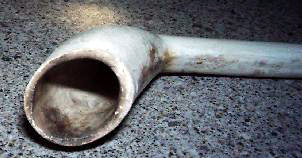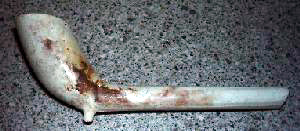

For most people, clay tobacco pipes bring to mind images of sailors and soldiers from the pre-civil war era, but did you know they've been around for over 300 years? Although there's no definitive proof of when they did come about, it's thought they originated in England in the late 1500s. "Tobacco drinking," as it was called then, was a favorite pastime of not only men, but women and children, too. Clay pipes were easy to make so the high demand could readily be met
| Clay Pipe Facts |
| The heel you often see on the bottom of a clay pipe is not for resting it on a table or to hold with your fingers - it helps clay pipe makers by adding extra material (or "bottom") to the pipe when the stopper is used to make the bowl. |
| Most tobacco "drinkers" preferred longer stems - since they tended to break, they could be used until they were fairly short, or had become "nose warmers." |
| Clay pipes were popular because they were disposable and easily replaced when they broke (which happened quite a bit). |
| When clay pipes have been smoked to the point where they are darkened in color and not as easily smoked, they can be made white again simply by placing them on top of hot coals or a wood fire. This clears out the tar and resins. |
| Clay pipe collections are easy to begin - most original clay pipes can be had for a few dollars, while some can go for as much as $100. Collections range from whole pipes to shards to partial pipes, plain, decorated, a certain style or time period, or a combination - it all depends on the collector. |
| Clay pipes were commonly made with kaolin clay (also called China or porcelain clay), as it was white or nearly white and had little shrinkage when fired in a kiln. | A red wax or lacquer was often placed on the end of the stem to prevent the clay stem from sticking to a smoker's lips and take away that "dry" feeling. |
The first clay pipes were described as being more of a spoon shape, formed like a "ladell," as noted in William Harrison's "Great Chronologie" from 1573. As years passed, the shape and size of the clay pipe changed so that it had more of a bowl-like shape to hold more tobacco and provide a longer "drinking" time. The size then was small, with a 4-6 inch stem, 1/4 inch diameter inside the bowl and a 1/8 inch stem bore, and many were flat on the bottom so they could be placed upright on a table or other flat surface.
Refinements were eventually made so that the bowls became larger, up to 3/4 of an inch inside and not as flat on the bottom. Stems became longer, some were 10-14 inches, with the majority of them straight, although curved stems were not unusual (this was due to distortion during the firing process).
 Clay pipe makers begin to add a milled or plain ring at the top of the bowl and some added
maker's marks or elaborately decorated the bowls by hand or with a stamp.
Clay pipe makers begin to add a milled or plain ring at the top of the bowl and some added
maker's marks or elaborately decorated the bowls by hand or with a stamp.
The 1700s brought better firing processes, a thinner bowl and overall better quality. But it was during the mid-18th century when extra-long pipe stems became the fashion of the day. Gentleman of that period enjoyed showing off their "aldermen" or "straw" clay pipes with their 18-24 inch stems. Decorative clay pipes were becoming rarer, save for those with a simple leaf pattern on the seams of the bowl, which remained popular.
As if the long stems from the mid-18th century weren't quite long enough, a new kind of clay pipe called the "yard of clay" was introduced after 1850. These "churchwarden" pipes had stems close to 36 inches long and were most likely not a good smoke, but more of a conversation piece as they were the fad at that time. One wonders if it became a contest among gentlemen to see who had the longest stem. Some claim that Charles Dickens came up with the name "churchwarden," and although there is no proof of this, he did help to make them popular at that time.
 Decorated pipes once again became popular and Victorian gentlemen tried to outdo each other
with the various types of decorations on their pipes. Some used them for advertising, some had
their favorite hobby (fishing, hunting, sailing) or food stamped on the bowl, while others selected
flowers or intricate designs. It got to a point where a customer could purchase a clay pipe to suit
their mood, their dress or their "claim to fame."
Decorated pipes once again became popular and Victorian gentlemen tried to outdo each other
with the various types of decorations on their pipes. Some used them for advertising, some had
their favorite hobby (fishing, hunting, sailing) or food stamped on the bowl, while others selected
flowers or intricate designs. It got to a point where a customer could purchase a clay pipe to suit
their mood, their dress or their "claim to fame."
Meerschaum pipes were introduced during the latter part of the 19th century, causing the clay pipe's popularity to wane. By 1930, the clay pipe had been reduced to a toy, used as bubble pipes for children or as targets at carnival shooting galleries. Briar pipes became the rage, didn't break like clay pipes tended to and were by far more durable in the long run.
Although some pipe collectors have kept clay pipes in the loop over the years, true interest in them didn't begin to rise until the last decade or so. This had to do somewhat with the discovery of clay pipes and pipe shards in rivers being dredged, or during construction of buildings on old farmland. But the majority of interest has come from re-enactments of Revolutionary War and Civil War battles. Where only historical societies or national parks such as Gettysburg previously planned these, more and more local communities have put together re-enactments of local battles or the way life was in that town back in the 17th and 18th centuries. Shipwrecks also brought discoveries of clay pipes, which is what happened to Stephen Bray of Glace Bay on Cape Breton Island in Nova Scotia.
"I was working as a scuba diver back in 1992 and one of the shipwrecks we found in Baleen Harbor contained hundreds of clay pipes," he explains. "They just lay on the bottom, mostly in shards, although there were some that were whole. I grabbed a few and brought them home."
 Bray's interest in these clay pipes caused him to find out more about them. He went to the library
and visited Fortress Louisbourg, a local historic site where Revolutionary-era soldiers "lived and
worked." Many of the costumed animators smoked clay pipes during their re-enactments and this
fascinated Bray.
Bray's interest in these clay pipes caused him to find out more about them. He went to the library
and visited Fortress Louisbourg, a local historic site where Revolutionary-era soldiers "lived and
worked." Many of the costumed animators smoked clay pipes during their re-enactments and this
fascinated Bray.
"About a year later, I got some clay and made my first clay pipe. I had no specific plans to go by, just what I'd seen and read," Bray says. "I took the finished pipe to Fortress Louisbourg and they were pretty surprised that although it wasn't an accurate pipe, it was a pretty good first attempt."
Trial and error ensued, with each clay pipe being handmade by "the eye" until Bray felt he'd come up with the perfect pipe. And it was. He began making clay pipes in earnest, accurately reproducing 17th, 18th and 19th century clay pipes.
By 1994 Bray was selling his pipes locally at first, and mostly to Fortress Louisbourg. By the end of this year, Bray estimates he'll sell over 800 pipes for the year. That sharp increase has been due mostly to the creation of his web site, Olde World Fine Clays, at http://www.bytor.com/pipes/pipes.htm. Since setting up the site in 1995, Bray gets 90% of his business from the site, with sales from all over the world including South America, Australia, the USA and Taiwan.
"I get most of my ideas for pipes and information from the library at Fortress Louisbourg - I don't know where I'd be without that resource," Bray adds. "I've been able to recreate some fairly accurate reproductions and my customers do love them."
These include 17th century clay pipes (11-inch stems), 18th century Dutch tavern pipes (16.5-inch and 11-inch stems), 18th century English churchwardens (14-inch stems) and 19th century English pipes (7-inch stems). Prices range from $15 for a custom 5-6 inch porcelain quality 19th century English pipe to $99 for an ebony oil clay 18th century Dutch tavern pipe. Each takes 50 minutes to create, then 10 days to dry before firing. The finished pipes are then hand-packed in wood shavings in its own custom pine presentation case.
But like most artists, Bray feels his pipes can be improved as he always strives for perfection. Working out of his small basement, he reflects on his dream - to have an 18th century pipe shop with all the proper tools, and more authentic to the way clay pipes were made back then. He'd like to use a proper old-fashioned kiln instead of the modern one he uses now, and offer more styles to choose from, as well as have others working with him - right now he figures he's doing the work of four men all by himself. His ultimate dream would be to have something a shop at Fortress Louisbourg.
Bray shrugs his shoulders and picks up a large handful of clay, then begins to knead and roll it, lost in thought as clay pipes begin to form in his hands.
Olde World Fine Clays
249 South Street
Glace Bay, Nova Scotia B1A 1W6
902-849-1383
Stephen Bray
J.A. Hitchcock is a regular contributor to Compute Me. Visit her web site at jahitchcock.com.